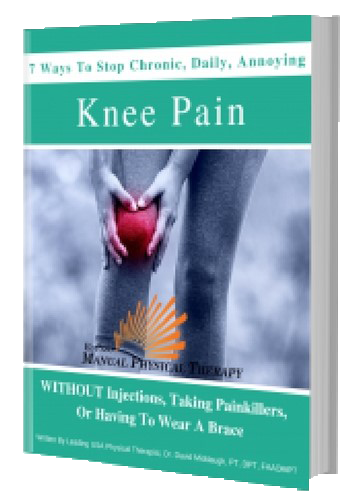TAP TO CALL (915) 503-1314

WILL WALKING MORE HELP IMPROVE PATELLOFEMORAL PAIN SYNDROME?
Walking is a common treatment exercise recommended by healthcare professionals to help improve patellofemoral pain syndrome, otherwise known as pain in front of the knee. But is it really effective at getting rid of that pain behind the kneecap? The answer is, it really depends on your situation.
Let me explain more, you need to understand why patellofemoral pain syndrome happens, I’m going to give you a super quick explanation. There’s a muscle imbalance that causes too much pressure to be developed in the knee joint.
When the thigh muscles in the front of the thigh here, the quads are too strong relative to other muscles in the hip and leg, then you’re going to get an increased pressure of the kneecap pressing against the thigh bone right here where it touches and rubs over.
If that increased pressure is there for too long, it’s just a matter of time before the cartilage in the back of the kneecap or on the end of the thigh bone right here begins to get irritated and inflamed and of course, painful and even swollen. The most common muscle imbalance that we see is two strong quads, and two weak glutes a lot of people think that their hamstrings need to be worked on.
But I disagree it needs to be the glutes because that directly shuts down the quads and takes that pressure off the kneecap so that you can do things without so much pain in the front of your knee. Now, if you have this muscle imbalance, walking will not improve your patellofemoral pain syndrome.
If you’re using your quads very consistently, whenever you go walking, and every single step you take your quads are contracting to help you do the walking motion, then you’re just further compressing and rubbing that kneecap with way too much pressure against the thigh bone.
This is why if you’ve already tried this out, if you’ve already gone to go walk maybe on the treadmill or outdoors somewhere, and you’ve tried to get exercise in walking for that kneecap and you feel worse afterwards or your knee starts to hurt after 5-10 minutes.
Maybe it doesn’t hurt during the walking but after the walking within minutes after the walking and it just bothers you the rest of the day, then walking is not a good thing for you and you’re probably overusing those quads, that’s a sign that your glutes are going to be too weak the buttock muscles and the glutes back here when they get stronger, they counteract the quads and they help to relatively shut down the quads and improve the forces or the pressures down in the knee joints.
And in some cases, people have a lot of trouble just tightening up their glutes. I mean, you could try this right now you’re suffering from a telephone pain syndrome. Right now, whether you’re standing or sitting, just think about trying to squeeze your glute muscles. If you can’t squeeze your glute muscles without also tightening the front of your thighs, the quad muscles, then you’ve got a problem you’re using your quads way too much.
So just since seated, try to tighten your bonds, you’ll lift up a little bit, that means your glutes are tightening up and try to not fire your quads. If you’re standing and try to squeeze these muscles, tighten them up without also tightening up these muscles on the front of your thighs. If you can’t effectively do that, then chances are you probably have a muscle imbalance that I’m talking about.
Your quads are going to be overactive because you can’t fire your glutes without firing your quads is going to compress that kneecap against your thigh bone. In some cases, extreme cases, you may not even feel your glutes contracting at all like they don’t tighten up. And it’s probably weird for you to get the sensation of trying to think about tightening up your glutes but your glutes don’t work and your quads work instead.
That is a severe muscle imbalance. And you definitely should not be doing any sort of walking for helping your patellofemoral pain syndrome because you’re only going to aggravate it. Instead you need to spend time trying to get your glutes to work without your quads also activating and you won’t do this in walking because there’s too much going on and walking your the pace you’re going at the steps using your whole leg, you need to go do some exercises where you isolate your glute muscles.
I’ve got a playlist of exercises actually two playlists down in the description below. Just go down in the description and find the links for glute exercises for knee problems. Now walking will help you patellofemoral pain syndrome.
If you do not have this muscle imbalance, if you try doing that little test right there, we try to tighten your glutes and you can effectively squeeze your glute muscles without your quad muscles dominating the entire activity that you’re doing, then you have a good chance at using walking productively to help your knee problem.
The trick is making sure that you have a coordination while walking. Because if you’ve already got the strength where you can tighten up the muscles, and you feel them working, and then you’ve got some coordination going where your quads don’t fire a whole lot you can get your glutes to work pretty independently.
Now you’ve got to figure out how to make your glutes work independently from your quads while taking steps. That’s a whole other process. I’ve actually got another video that talks All about that. It’s also linked in the description below. Go check that out. It’s called does walking help knee pain.
And that video will show you exactly how to fire your glutes while walking is if you can walk like that and use your glutes effectively, then every single step, you take that you’re no longer using your quads, and now you’re using your glutes while walking. It’s taking that pressure off the kneecap.
And you’re putting good pressures to the knee joint here, which is actually helpful for the cartilage. And then you should have the experience where if you go walking as long as you don’t do too much more than you’re used to doing or what your body’s capable of doing. If you walk within your tolerance, then it should be beneficial for you to go walking. It should actually help your kneecap or patella femoral pain syndrome.
Hope this video was helpful for you give us a thumbs up if you thought it was helpful. And don’t forget to share it with a friend that you think needs to hear this. I’ll see you in the next video. Bye
Would You Like To Talk With A Specialist?
Appointments and Questions Call: (915)503-1314
EL PASO MANUAL PHYSICAL THERAPY
2601 E. Yandell Drive, Suite 232
El Paso, Texas 79903
© 2023 El Paso Manual Physical Therapy, PLLC, All Rights Reserved
